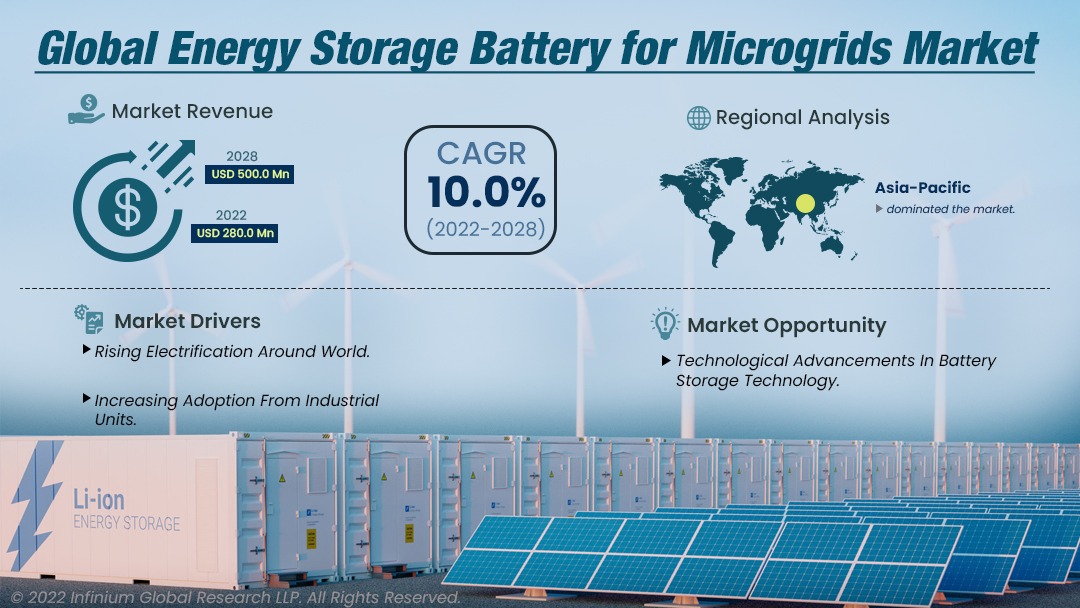Energy Storage Battery for Microgrids Market (Type - Sodium-sulfur Battery, Lithium-ion Batteries, and Others; Applications - Household/residential, and Enterprise): Global Industry Analysis, Trends, Size, Share and Forecasts to 2028
A recent report published by
Infinium Global Research on the energy storage battery for microgrids market
provides in-depth analysis of segments and sub-segments in the global as well
as regional energy storage battery for microgrids market. The study also
highlights the impact of drivers, restraints, and macro indicators on the
global and regional energy storage battery for microgrids market over the short
term as well as long term. The report is a comprehensive presentation of
trends, forecast and dollar values of global energy storage battery for the microgrids market. According to the report, the global energy storage battery
for microgrids market is projected to grow at a CAGR of over 10% over the
forecast period of 2022-2028.
Market Insight
The revenue generated by the energy storage battery for microgrids market was over USD 280 million in 2022 and is expected to reach more than USD
500 million in 2028 and is expected to grow with a CAGR of over 10% over the
forecast period 2022-2028. Within the energy community, energy storage methods
for microgrids are becoming a highly promising and hotly debated topic.
Utilizing batteries as energy storage is one possibility for microgrids. In
battery energy storage systems (BESS), the generated energy is stored using
lithium-ion, magnesium-ion, or another type of choice. The solution being
explored to relieve utility networks from aging and demand stress may be
microgrid BESS. This approach may also help the current grid structure last
longer while addressing upcoming problems, such as peak demand, peak shaving,
maintaining high and low voltage swings, and future power needs. Future use
patterns of the community it serves must be taken into account when designing
the architecture and layout of the microgrid BESS.

Electrification is growing at
a rapid pace globally, especially in developing countries. For instance, in 2020,
99% of the population in India had access to electricity which was 89.2% in
2016 according to World Bank. The growing electrification has brought many
rural areas under the national grid and has led to the establishment of numerous
microgrid plants in rural and far-flung areas which has tremendously increased
the scope of application of energy battery storage systems for microgrids. This
factor is thus majorly driving the market. In urban areas, the use of energy
storage battery for microgrids from industrial units is growing at an
increasing rate. Industrial production around the world is growing rapidly
which has increased the demand for power and thus the microgrids for industrial
units are being set up at a faster pace. Thus, the demand for energy storage
battery systems is expected to grow from industrial units. But the high cost
associated with maintenance is hampering the growth of the market in the
medium term. However, new technological advancements in battery storage
technology are expected to boost growth opportunities in the market.
COVID-19 had a bad effect on
the market for Energy Storage Batteries for Microgrids. Installation efforts for
energy storage battery for microgrids have been greatly hindered by the rapid
implementation of physical restrictions and the strict measures for containing
the COVID-19 infection. The planned activities have to be delayed due to supply
chain disruptions. There was a tiny pool of workers that were available as the
social distance laws were implemented. Additionally, the manufacture of crucial
components was impeded as a result of supply chain disruptions. The need for
electricity during the outbreak increased dramatically, while Microgrid power
generation received essentially no attention.
The global energy storage
batteries for microgrids market is segmented into North America, Asia-Pacific,
Europe, and the RoW region. Asia-Pacific dominated the energy storage battery
for microgrids market in terms of revenue. Developing countries in Asia-Pacific
such as India and China have intensified their electrification process in order
to provide electricity to far-flung areas. The increased electrification
has put tremendous pressure on the existing grids and also there are efforts
for upgrading the grids. Solar power has emerged as the easiest way for
generating electricity for developing countries such as India and China. Thus,
energy storage batteries are being adopted for solar microgrids supplying power
to residential areas. Also, countries such as Japan are home to influential
market players such as Panasonic Corporation, Samsung SDI, NEC Corporation, and
others. North America is expected to be the second largest region in the market
owing to the growing demand from the residential and industrial sectors.
Segment Covered
The report on the global energy
storage battery for microgrids market covers segments such as type, and
applications. On the basis of type, the sub-markets include sodium-sulfur
battery, lithium-ion batteries, and others. On the basis of applications, the
sub-markets include household/residential, and enterprise.
Companies Profiled:
The report provides profiles of
the companies in the market such as Samsung SDI, NGK Group, Panasonic
Corporation, Toshiba Corporation, MHI, Sumitomo Electric, CALMAC, S&C
Electric, and OutBack Power.
Report Highlights:
The report provides deep insights into demand forecasts, market trends, and micro and macro indicators. In
addition, this report provides insights into the factors that are driving and
restraining the growth in this market. Moreover, The IGR-Growth Matrix analysis
given in the report brings insight into the investment areas that existing
or new market players can consider. The report provides insights into the
market using analytical tools such as Porter's five forces analysis and DRO
analysis of energy storage battery for microgrids market. Moreover, the study
highlights current market trends and provides forecast from 2022-2028. We also
have highlighted future trends in the market that will affect the demand during
the forecast period. Moreover, the competitive analysis given in each regional
market brings insight into the market share of the leading players.
